Chris, Adam, Jamie and I had another DBA RRR game, with 24 Elements, set in the Italian Wars. I think everybody enjoyed it. Chris and I won as the French. I found it a bit odd that pikes avoid fighting shot, in fact everybody avoids fighting shot, and shot don’t really need support by pikes against anything. My conclusion is that shot is a DBA-RRR super troop.
Armies
We used my scheme for Choosing a date for a DBA-RRR game in the Italian Wars and Jamie picked this one out of the hat:
Option 9: Landriano (1529). I/2 French (d). I/5 Spanish Imperial (a). Historical result: Spanish Imperial defeated French.
We also used my recommendation for Constructing 24 element armies for DBA and DBA-RRR i.e. to double the compulsory troop types and leave the optional troop types the same.
For the French that meant the army list was:
Army List: I/2(d) Italian Wars French. 1523-1535 AD:
- Arable. Ag: 3
- 2x Kn (g)
- 2x Kn Ordonnance gendarmes
- 4x Pk Swiss pikemen
- 2x Sh Aventuriers with arquebus
- then 14 from:
- 1x Kn Ordonnance gendarmes
- 2x Kn Ordonnance archers
- 1x Kn* Ordonnance archers *(can only be taken if the additional Ordonnance gendarmes are taken also)
- 1x Kn Italian elmeti
- 1x LH Italian mounted arquebusiers
- 1x LH Stradiots
- 2x LH Argoulets with arquebus
- 1x LH Mounted crossbowmen
- 4x Pk Old bands of Picardy and Piedmont
- 3x Pk Landsquenet pikemen
- 2x Pk Aventurier or Italian pikemen
- 2x Pk Swiss pikemen
- 1x Sk* Swiss skirmishers *(must be taken if both additional Swiss pikemen are taken)
- 3x Sh Aventuriers with arquebus
- 2x Sh Italian arquebusiers
- 3x Can Heavy and or field guns
And for the Spanish the army list was:
Army List: I/5(a) Spanish Imperial 1519-1533 AD
- Arable. Ag: 1
- 2x Kn (g) Spanish gente de armas
- 2x LH Spanish ginetes
- 2x Pk Landsknecht pikemen
- 4x Pk Spanish colunela pikemen
- 4x Sh Spanish colunela arquebusiers
- then 10 from:
- 1x Kn Burgundian men at arms
- 2x Kn German men at arms
- 1x Kn Italian elmeti
- 1x LH Spanish ginetes
- 1x LH Italian horse arquebusiers
- 1x LH German mounted crossbowmen
- 1x Pk Landsknecht pikemen
- 2x (1x Pk + 1x Sh) Spanish colunela pikemen and arquebusiers
- 1x 3Bd Spanish colunela sword-and-buckler men
- 2x Sk Unregimented arquebusier companies
- 1x Sk Skirmishing Spanish musketeers
- 2x Hd “Indifferent” Italian foot
- 1x Can Field guns
Deployment
The table had a couple of hills (one gentle, one rough), a wood, a town and a stream.


For the French, Chis’s deployed on the left on, and around the gentle hill. He had foot on the hill, gendarmes to their left flank, and two cannon to the centre. My command was divided on each side of the wood in the right-centre. In fact my command was further divided by the stream. I had foot and light horse on the far side on the stream and gendarmes squashed between the wood and the stream. My remaining troops were pike and shot between Chris’s cannon and the wood.

The Spanish massed around the town. Jamie had shot in the town, pike and shot behind the town extending out to the flank, plus horse behind them. Adam had foot between the town and the rough hill, skirmishers on the hill, and light horse beyond the stream. James and Adam didn’t quite realise the difficulties their deployment would offer them.

The battle
I took a risk with having my general start in the wood. I wanted him, and his gendarmes, out of the bad going as soon as possible.

Jamie was desperately trying to move around the town. Some of his troops shuffled towards the centre of the table.

In front of the wood, I started expanding out my line.

On the far side of the river, my flanking forwards started inching forward.

Chris followed along and advanced all along the line.
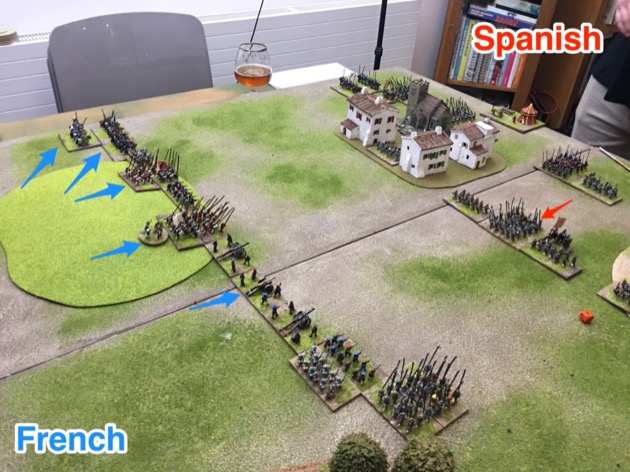
I advanced my forces as quickly as I could. I wanted to form a line, beyond the wood, around the middle of the table.

Chris’s grand battery opened up and immediately destroyed some Spanish pikes.

The Spanish advance in the centre and beyond the town.

Beyond the stream I kept advancing my flanking forward as fast as spare PIPs would allow.

Jamie wanted to get his men-at-arm into contact with Chris’s cannon so he had to swing around the front of the town. This did look a bit of a gamble to Chris and I, but, being French, we said nothing.

The Spanish had learnt their lesson and started to shy away from Chris’s guns.


The next casualties were some Spanish pike, shot down by French adventuriers.
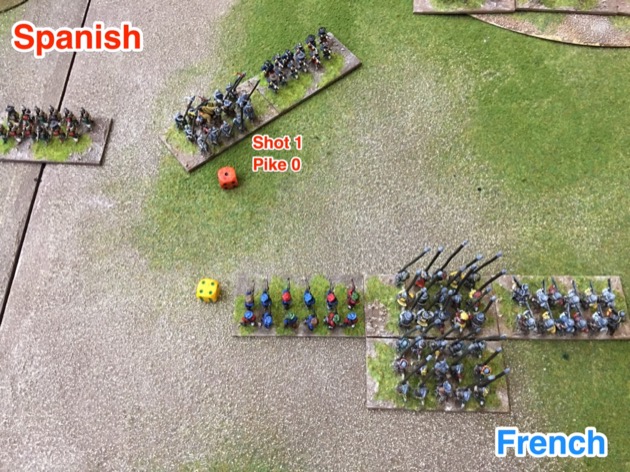
But the Spanish arquebusiers immediately took revenge on the adventuriers.

As Chris advanced on the far left flank I started to pull back to avoid the Spanish shot. I found that weird, that pikes would have to flee the threat of shot rather than going in with cold steel. Something wrong there.

I got some pikes and gendarmes lined up with the Spanish shot in the centre. But didn’t quite get into contact.

And beyond the river my flank force kept edging forward.

So I’d already discussed that pikes dissolve in front of shot. Now I found the knights also disappeared quick. Adam’s Spanish shot destroyed some of my gendarmes.

And over on our left, the Spanish arquebusiers killed some more gendarmes.

Jamie had two units of gente-d’armes in front of the town. Chris threatened the flank of one, leaving the other to advance alone. Meanwhile the French cannons continued to boom and in the centre Adam brought his Spanish off the hill to confront the French.

The French cannon scored again.

I had an annoying situation with just my general in contact with the Spanish and my pike and shot just short.

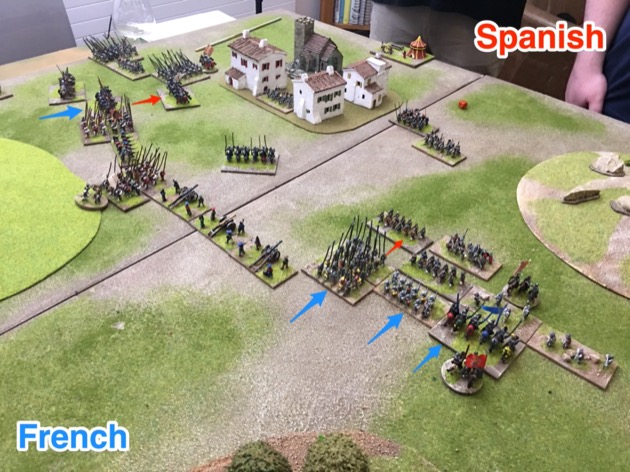
Despite being outnumbered my general cut down his Spanish counter-part. Morale of that story, gendarmes + general beat skirmishers + general.

Near the town French gendarmes destroyed Spanish gente-d’armas.

The French centre and left now look dominate.

Italian shot in French service shoot down some Spanish pikes on the far French left. Once again proving the superiority of shot in DBA-RRR.
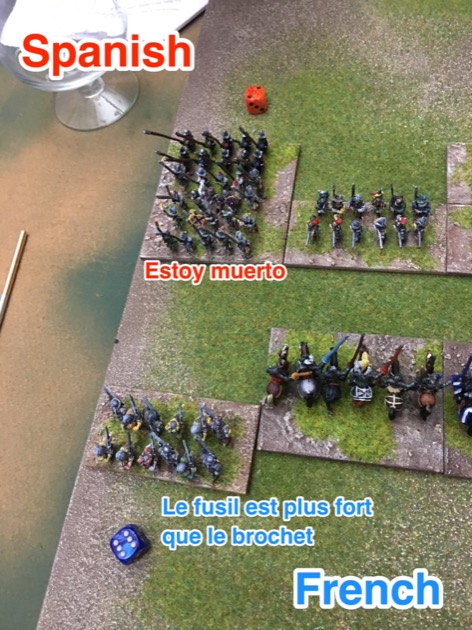
And in the centre more Italians take the game for the French. This time a shot on shot match. Although the Italians were assisted by French gendarmes on the Spanish flank.
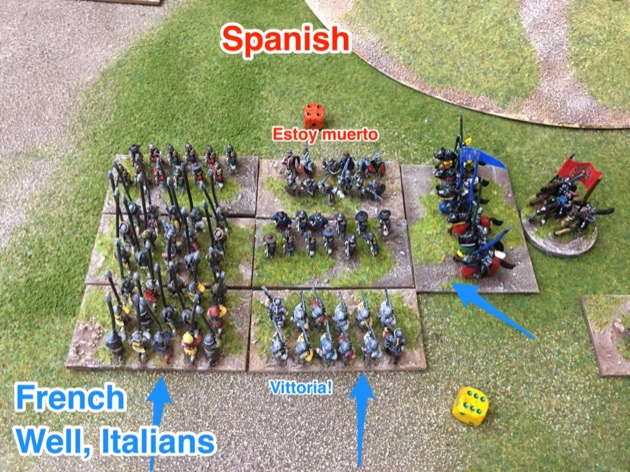
And that was the game.

Conclusions and observations
It was a good game, enjoyed by all. Chris and I won as the French. Of course my loyalties were torn as I’d have much preferred being Spanish.
Jamie and Adam hampered themselves by setting up behind the town. Bit of a novice error. They assumed they could easily move around it. Unfortunately this hampered them for the entire game.
The two tweaks I made, the scheme for Choosing a date for a DBA-RRR game in the Italian Wars and the recommendation for Constructing 24 element armies for DBA and DBA-RRR, both worked out well. We have a simple way of selecting the date and hence army lists. And the 24 element armies, with doubled compulsory troops and not others, seemed more balanced than other options we’ve considered.
But not everything was rosy. I found it quite odd that pikes avoid fighting shot, literally run away from them as fast as possible. In fact, by the end of the game, all non-shot troops were avoiding fighting shot if they could get away with it. Shot are a DBA RRR super troop type. This was even evident even before the battle began, in the choice are armies, when both sides maximised the number of shot elements.
In this period pike were the predominate infantry arm. Shot could prevail against pike, but only when the pikes were stalled in front of the shot, for example by fortifications. Shot couldn’t stop pikes in the open. This is not true in DBA RRR. Shot gleefully hunt down pikes and the pikes try to avoid confronting them.
Historically, to survive knights, shot either sheltered under pikes or hid in rough ground. In DBA RRR there was no evidence that shot need support by pikes against anything. In the game shot could stand up to knights in the open, without support by pikes. I could accept this if the shot were sheltering in rough, but they weren’t. Our game was fought in the open.
I’m quite uncomfortable with that with the issues with shot. Somehow I’m left feeling DBA RRR are not a good fit for the Italian Wars.

Any hope of an RRR 3.0 to fix this and other issues, do you know? – Paul H
I know Tony Aguilar is intending a DBA-RRR 3.0. An DBA 3.0 changes a lot of things. But those changes are not what I see as the problem with DBA-RRR.
Hi Steven, thanks for another well written report, about a rule-set that I’ve been really interested in for some time.
Worrying though. Your experience with Shot is a real issue, as I have this DBA adaptation lined as the first of 2 or 3 rule-sets for my renaissance project!
Your post sent me back to look at my copy of the rules, which describe Shot as ‘vulnerable to charging cavalry unless protected by neighbouring pikes or close terrain, and to deep Pikes unless holding an entrenchment’. Hmmm, maybe not in fact, as far as these rules are concerned!
Then I started wondering whether this was a problem of exposure to fire? In other words a problem with the relationship between the shooting range of Shot and the movement rate of enemies?
It doesn’t look like that’s the case for mounted, which need suffer no exposure to distant combat at all if the owning player judges the approach march correctly. But I see that you found that ‘all non-shot troops were avoiding fighting shot if they could get away with it’, so I presumed that mounted were suffering as well.
Pikes or blades will usually suffer two rounds of distant combat as a minimum before contact but that’s no different from standard DBA.
Then I had a look at the combat factors and was interested to see that Shot are classified as significantly more destructive than Bows against foot (CF 4 vs CF 2) and on a par against mounted (CF 4 / CF 4).
I can see why Shot might be thought likely to do better than Bows during this period, simply because armour was significantly improved and the evidence from the sources is that the use of the bow was declining but that might well be for other reasons. Opting to give Shot a CF of 4 against foot, compared with 2 for Bows doesn’t feel right. If anything I’d be inclined to downgrade the Bows but that will cause a reduction in the Bows performance against troop types that don’t really differ from the same type in vanilla DBA, so that doesn’t seem right
Now I’m reluctant to dismiss DBA RRR, because I’d like to have a DBA variant for this period – it seems such an obvious fit. So what’s might we do? Here’s my starter for ten.
First, reduce the range for Shot in distant combat from 200p to 100p, because gunpowder weapons probably had a much lower effective range than bows during this period (regarding the period, see the note below). This will mean that even foot can contact Shot without suffering any shooting if the Shot stand in the open to receive them.
Second, perhaps having tried the first on its own, reduce the CF for Shot against foot AND mounted to 3.
Of course this all presumes that we must differentiate Shot from Bows in this period. In fact the relative performance might have been the same. Armour got better but shot was better at defeating it and bows became less prevalent for reasons I’m not sure of.
Regarding the period covered by the rules, I think 1500ish to 1700ish is much too wide a span. When I use the term ‘renaissance’ I really mean the 16th century, roughly.
Hope that’s all of some use. Of course I’m hoping you might try the idea and see how it works because I haven’t got my renaissance project to the table yet but even if you don’t, at least I’ve got it off my chest.
Best regards,
Chris
> Shot as ‘vulnerable to charging cavalry unless protected by neighbouring pikes or close terrain, and to deep Pikes unless holding an entrenchment’.
That neatly describes the historical performance. But not performance in DBA-RRR.
> Then I started wondering whether this was a problem of exposure to fire? In other words a problem with the relationship between the shooting range of Shot and the movement rate of enemies?
as you spotted, shot are effective against all troops.
> Then I had a look at the combat factors and was interested to see that Shot are classified as significantly more destructive than Bows against foot (CF 4 vs CF 2) and on a par against mounted (CF 4 / CF 4).
> I can see why Shot might be thought likely to do better than Bows during this period, simply because armour was significantly improved
The English had a big debate about bow v shot. I’d argue, like old fashioned English, that bow was better as a weapon. At least the way the English used bows.
> and the evidence from the sources is that the use of the bow was declining but that might well be for other reasons.
Bows declined because training a good bowman was really time consuming and hence expensive. English bowmen required constant practice over many years.
Training a arquebusier took a couple of weeks and required no on going practice.
Economics.
Not combat factors 😉
> Opting to give Shot a CF of 4 against foot, compared with 2 for Bows doesn’t feel right.
I don’t think the significant comparison is with bow. It is how these factors compare with the combat factors of infantry in general. Shot = 4. Pike = 3. Say no more.
> Now I’m reluctant to dismiss DBA RRR, because I’d like to have a DBA variant for this period – it seems such an obvious fit.
I agree. That is why I tried DBA-RRR.
My experience of DBR was it was okay for 16th century and poor pretty simulation for 17th century.
Since I was looking for something for the Italian Wars (16th century) I thought DBA-RRR was worth a look.
> So what’s might we do? Here’s my starter for ten.
Cool
> First, reduce the range for Shot in distant combat from 200p to 100p, because gunpowder weapons probably had a much lower effective range than bows during this period (regarding the period, see the note below). This will mean that even foot can contact Shot without suffering any shooting if the Shot stand in the open to receive them.
I’ve written rules with realistic ranges (Twilight of the Sun King).
I’ve written rules with unrealistic ranges (Tilly’s Very Bad Day).
Weirdly, on balance, I find the latter gives a better simulation.
> Second, perhaps having tried the first on its own, reduce the CF for Shot against foot AND mounted to 3.
Bingo.
A combat factor of 4 makes Shot the equivalent of Elven archers with Legolas attitude (yes, I play HoTT).
It doesn’t make sense in the Italian Wars.
Even 3 might be generous since that makes them comparable to pikes in close combat. Okay, the pikes will probably have a rear rank and hence jump to 6. So maybe that is fine. And shot will need those fortifications (which do not feature in DBA-RRR by the way) to stand up to deep pikes.
And 3 is comparable to Knights. But at least the knights get a kill factor.
> Regarding the period covered by the rules, I think 1500ish to 1700ish is much too wide a span. When I use the term ‘renaissance’ I really mean the 16th century, roughly.
I agree.
But, as I said, my DBA-RRR interest is just 16th century.
Thanks for the thoughts/suggestions.
Gosh, that was a quick turn around. It’s seems we’re both on much the same page here but I’d just like to follow up on your response about ranges, vis; ‘I’ve written rules with … better simulation.’
My reason for suggesting the reduced range wasn’t really about realism* but about balance. If the Shot has a range of 200p and the Pike move 200p that means that the Shot will get two attempts to eliminate the Pike before the Pike get any chance to reply. That just makes an already unbalanced combat three times worse. My apologies if I’m telling you something that you’d already worked out but I think it makes nearly as much difference as the difference in factors.
realism* – I’m not particularly bothered about this. I find too much distortion between range and declared game scale does grate but it doesn’t stop a game being a good game. Commands & Colours is a very good case in point.
On a different note, I heartily agree with your comment ‘shot will need those fortifications (which do not feature in DBA-RRR by the way) to stand up to deep pikes’. I wonder if that might best be handled in DBA RRR by adding fortifications as another terrain type? I’m pretty sure that HFG does something like that, though I haven’t used that rule while playing.
Have a great weekend,
Chris
Hi Steven, I also wanted to say that the battle reports on the Balagan are looking very good. The supporting text is informative but punchy. The photography is very good too and it’s really enhanced by the neat annotation. I’m very interested to know how you do that and what software you use. Regards, Chris
The annotations are using Skitch. I had a much more complicated approach (see How to Edit/Annotate Images for Crossfire Battle Reports). But it was too time consuming. Now I just use skitch and leave out the fancy stuff.
Thanks. If only I was a Mac user. (Looks like Evernote no longer supports Skitch for Windows Desktop. Never mind, there are alternatives.
If you are a PC user, I’d suggest MS Paint. It won’t look quite like what Steven uses but it’s fairly easy to add text and some arrows.